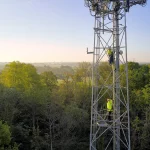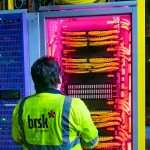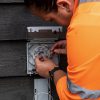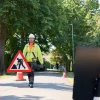Better Rural Broadband and Mobile Could Boost UK Economy by £65.1bn

New research from network operator Virgin Media (VMO2) and economic consultancy Cebr has claimed that £65.1bn could be added to the UK economy and employment could be increased by 6.8% (creating an additional 284,000 new jobs), but only provided all rural areas get access to “excellent digital connectivity“.
According to Ofcom’s data (here), some 97% of UK premises are already within reach of a 30Mbps+ capable fixed-line broadband network, which falls to 73% for gigabit-capable speeds, while just 1.4% are unable to access speeds of 10Mbps+ (USO level). As for mobile connectivity, 4G reaches 80-87% for geographic coverage across all operators, while 73-82% of premises can get outdoor 5G coverage via at least one operator.
Sadly, rural areas are often the last to benefit from digital connectivity upgrades, which can leave areas such as tourism, agriculture, manufacturing, and small businesses at a disadvantage. But the new report – The Great Rural Revival – suggests that solving this could deliver a huge economic boost.
Advertisement
However, the report is fairly short and basic, which is probably because it was based on an Opinium survey of just 1,096 rural respondents with a decision-making role on tasks related to digital connectivity. VMO2 and Cebr then used this to derive the difference of quality in rural and urban connectivity, and by how much turnover and employment could increase if rural businesses had “excellent digital connectivity“. Take with a pinch of salt.
Biggest Benefits from Excellent Rural Connectivity
➤ The sector as a whole would grow turnover by 10.5% – a rise of £65.1 billion across businesses in current prices. Further, employment in rural areas would grow by 6.8%, equivalent to creating 284,000 new jobs.
➤ The East of England would benefit most from digital connectivity upgrades, unlocking a £12 billion boost for the local economy and 42,000 new jobs.
➤ Other regions set to benefit include the South West, where the local economy could unlock £7 billion and benefit from 39,000 new jobs, as well as Wales, where £5 billion could be unlocked alongside 25,000 jobs.
➤ Rural tourism businesses could increase turnover by 9.9% (equating to an extra £842 million per year) and boost employment by 3.8% with improved connectivity.
Overall, our impression of reading this research is that VMO2’s report is more focused on promoting the operator’s own efforts to upgrade mobile and broadband connectivity, rather than in actually doing a deeper analysis of the issues. For example, the report highlights VMO2’s recent Starlink trial in remote Wales (here), while noting their 4G upgrades under the ‘Shared Rural Network’ programme, as well as their planned full fibre upgrades and so forth.
Jeanie York, Chief Technology Officer at Virgin Media O2, said:
“At a time when communities across the UK are struggling, this new analysis demonstrates how improved rural connectivity could herald a Great Rural Revival. The last decade has seen fixed and mobile networks rolled out to new corners of the UK, and now the transformational potential of connectivity has been made clear with the ability to unlock £65 billion of new growth in rural areas.
Through working closely with industry partners, the UK Government, planning authorities and landowners, we can deliver the essential network upgrades that will help to bridge the rural-urban connectivity divide, provide faster and more reliable coverage and unlock new jobs and growth in the process.”
One of the biggest problems with this report is that they’ve defined “excellent connectivity” in a very unspecific way, basing it off a vague score of ‘10’ for both fixed and mobile connectivity when survey respondents were asked to rate the quality of their connectivity. This was then used alongside questions around anticipated turnover and employment changes to calculate the impact to the rural economy as a whole.
In our view, that approach just seems a bit too weak and anecdotal to give an accurate picture, particularly as such opinions do not always reflect the actual availability of better networks (e.g. you might be unhappy with what you have, but may also be unaware that better connectivity already exists).
Advertisement
As we always say when such reports surface – trying to accurately gauge the economic impact of deploying faster broadband or better mobile is notoriously difficult, not least since most premises won’t be starting from a point of zero connectivity and many of the most common tasks (e.g. online shopping, banking etc.) only need a fairly basic connection. Not that better connectivity isn’t needed, but there can be an issue of diminishing returns.
The government are currently working to improve rural broadband and mobile connectivity via a variety of changes (e.g. softer planning rules, easier infrastructure sharing and better access to upgrade existing sites) and programmes. For example, there’s the £1bn industry-led Shared Rural Network (SRN) project that aims to extend geographic 4G coverage to 95% of the UK by the end of 2025 (it may also help the 5G rollout).
On top of that, there’s also the £5bn Project Gigabit rollout that aims to ensure that a minimum of 85%+ of UK premises can access a gigabit-capable broadband ISP connection by the end of 2025, before possibly reaching “nationwide” (c.99%) coverage by the end of 2030 (here and here). Not to mention various other programmes across Scotland, Wales and Northern Ireland.
Finally, a number of technology trials are also being conducted to test Fixed Wireless Access (FWA) and LEO satellite based broadband solutions for rural areas (examples here and here).
Advertisement
Mark is a professional technology writer, IT consultant and computer engineer from Dorset (England), he also founded ISPreview in 1999 and enjoys analysing the latest telecoms and broadband developments. Find me on X (Twitter), Mastodon, Facebook, BlueSky, Threads.net and Linkedin.
« UK Ranks 34th out of 220 Countries for Broadband Speed in 2023
NET CHECK Mobile Testing Names Vodafone UK Best for London »






















































And exactly how much rural build does VMO2 do / have they ever done?
interesting for VMO2 to pay for that study, considering their contribution to rural wired broadband is virtually zero (where it does exist, it’s normally “rural” suburbia around cities) and their rural mobile coverage leaves a lot to be desired.
(do they even offer a home mobile broadband service, or are they all too aware that they wouldn’t be able to cope)
This “research” will be part of a wider strategy that separately involves a lot of ministerial lobbying by VMO2, who like most large companies have a well paid team to do such things. The conversation runs as follows:
“Hello Minister, we’re here to talk about advancing Britain’s creaking digital infrastructure, and how private sector investment can unlock up to £65bn of benefits and economic growth. Obviously we’ll put up the money, but there’s one tiny snag, all these rural locations with safe seats for the government, well, they just miss our hurdle rates. If you could see to it that the investment is supported, well that would enable us to invest, create growth, and you’ll be the minister delivering on the policy goals of unlocking growth, making Britain digital, ensuring net zero, eliminating the digital divide, levelling up….blah blah blah”.
For those unfamiliar with how democracy works, a minister spends one day a week on constituency matters, perhaps a day a week in assorted cabinet and party politicking, and the other three days are crammed full of ministerial matters, the majority of which are lobbying meetings with business, either directly, through professional lobbyists, through industry associations or the like. So lobbyists have three times as much face time and influence as voters. You might well ask who actually speaks for the citizens of this country? Well, nobody, certainly not the people in Westminster, quaffing the booze we subsidise, or stuff the meals we also subsidise. They’re too busy being influenced by business.
If a few hundred thousand quid on lobbying can win you a few tens of millions in assorted subsidies, that’s a great return for the company.
Obviously they have next to no rural footprint, but maybe this is an interesting preamble to them buying over an Altnet that does do it..
Not entirely impossible, but seems a high estimate given that a more comprehensive study over several months by IPSOS MORI put the BCR of good broadband in harder to reach areas at between 3.5 and 5.1
That put the socio-economic benefits of Project Gigabit (£5bn) at between £17.5bn and £25.5bn.
https://www.gov.uk/government/publications/superfast-broadband-programme-state-aid-evaluation-report-2020
The problem remains that local and rural planners alike continue to reject even very reasonable planning proposals to build new or upgrade existing sites.
One example that I’m familiar with is in North Somerset.
3 / EE applied to slightly increase the height and width of an existing mast that’s in the middle of a hill surrounded and by trees – it would have brought 5G and faster 4G to a largely rural area / mostly small villages.
Despite no local objections from either residents or the local parish council, the planners sitting in Bath some 12 miles away still rejected it on the grounds the development is unsuitable and the mast could be placed somewhere else – which is unlikely given the local topology. I’d put good money on the planners having never even visited the site for themselves.
To illustrate the ridiculous nature of the decision view these links:
1. Streetview of the existing mast – it’s in the middle of the clump of trees – all off which are now higher than the mast – the photo is from 2018:
https://goo.gl/maps/gqnmx6quYsYJJqTZA
2. The planning application / image of the proposed mast – see the attachment “proposed elevation”:
https://www.bathnes.gov.uk/webforms/planning/details.html?refval=23%2F00077%2FFUL#documents_Section
People continually criticise the operators for slow rollout but even when they try to do upgrades in badly served rural areas they are literally fighting with their hands tied behind their backs.
And it’s not just rural areas – in my urban area 22 out of 23 applications by 3 have all been rejected – which means they’ve spent well over £2m in surveys and plans to get precisely nowhere.
Something doesn’t seem to tally/figure here, @NIMBY
The original tower according to the existing elevation is 17.5 m agl. The 2018 street view suggests the tree tops then were about 15 m agl (based on just the antennae being visible in the existing elevation state). And you say the trees have grown since the 2018 photo and are now above the level of the old mast height. Let’s, for argument, say 18 m.
But the new planning application drawing still has tree-top level as ~10 m agl, which would lead the planners to think that ~11 m of the new mast would be visible above the tree line. So, yes, it’s likely true what you said about the planners not making a site visit (since they’d have presumably noted the true existing tree height was not according to the plan). And so it may be understandable why the planners rejected the planning proposal as unsuitable. One would have to read the reasons for rejection to come to a firm view on that.
But perhaps if whoever drew and/or approved the new planning drawings had made a site visit then they’d have also noted the approx tree level is now ~18 m agl and that only about 3 m of the new mast would be showing. If they then had amended the plans to reflect this situation and had noted that this would be roughly equivalent to the position of the existing mast in 2018 then perhaps a planning refusal would not have transpired.
If a refusal had been handed down with plans showing the true position of the mast in considering that, in effect, there was little change from the position in 2018, then that would definitely seem to be perverse to me, but that’s not what seems top be the case here.
Surely the problem here is that the planners refuse to accept that things have to change if they want progress. When we built proper national electricity networks, it was accepted that you’d have to have pylons. When telephones were a new fangled thing, it was accepted that you had to have telegraph poles. But over time, Britain has become a place where progress has slowed, and even fossilised. You’ve got the Welsh government announcing an end to road building. You’ve got councils everywhere resisting new mobile network masts, in some areas allegedly making life difficult even for FTTP roadworks.
Well personally I find O2 and Vodafone to this day absolutely destroy EE in the areas of the countryside I know best, i.e. most of Hampshire and Surrey. EE and Three are hopeless.